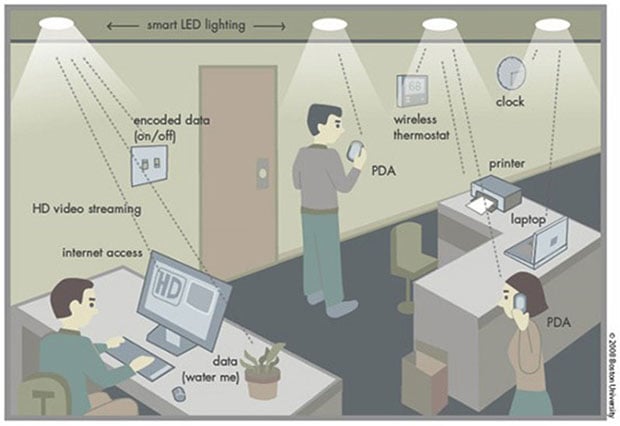First Successful Test Of Li-Fi Wireless Light Network Yields Speeds 100x Faster Than Wi-Fi
We’ve all heard about Wi-Fi — the ubiquitous wireless networking standard is commonplace in just about all of our gadgets (smartphones, tablets and notebooks) and even our cars, as well as some home automation and IoT products. It’s hard for most people not to go a day without using Wi-Fi at some point, and with technologies like 802.11ac, we’re transferring data over the air at fantastic speeds (or so we thought).
However, Professor Harald Haas, hailing from the University of Edinburgh, has invented Li-Fi, which uses visible light communication or VLC, to transmit data wirelessly at high speeds. In its current iteration, Li-Fi uses LED lights, which flicker at a rate that is imperceptible to the human eye, to transmit data. Researchers from the University of Oxford were able to hit bi-directional Li-Fi speeds of 224 Gbps earlier this year in a lab setting. To put that in perspective, those speeds would allow 18 high definition movies to be download in a just one second.
And of course, more speed is better. What if we told you that researchers at Velmenni based in Estonia have moved past these lab trials onto a pilot program which uses an even faster version of Li-Fi in a commercial setting. Instead of “mere” 224 Gbps speeds, Velmenni was able to top 1 GBps, roughly 100 times faster than current Wi-Fi technology.

Li-Fi Network Topology - Credit: Boston University
Velmenni CEO Deepak Solanki envisions Li-Fi being pushed into the consumer space by the end of this decade, and would allow for very easy retrofits as existing light fixtures could be replaced with Li-Fi-capable LED lighting.
"In the future we will not only have 14 billion light bulbs,” explained Haas “We may have 14 billion Li-Fis deployed worldwide for a cleaner, greener and even brighter future."
And interestingly enough, Li-Fi would actually lead to greater security without all of the interference of existing Wi-Fi solutions, as light (and hence data transferred) wouldn’t be able to penetrate walls, allowing for controlled delivery with network repeaters.
This security perk would limit the usefulness of Li-Fi in certain environments, but still could allow for both Wi-Fi and Li-Fi to be used together where deemed appropriate. And that makes sense; Wi-Fi is too entrenched for it to be tossed aside overnight. And there will no doubt be advances like "802.11ax" which will provide reported speeds of 10 Gbps, all while promising backwards compatibility with earlier standards.

